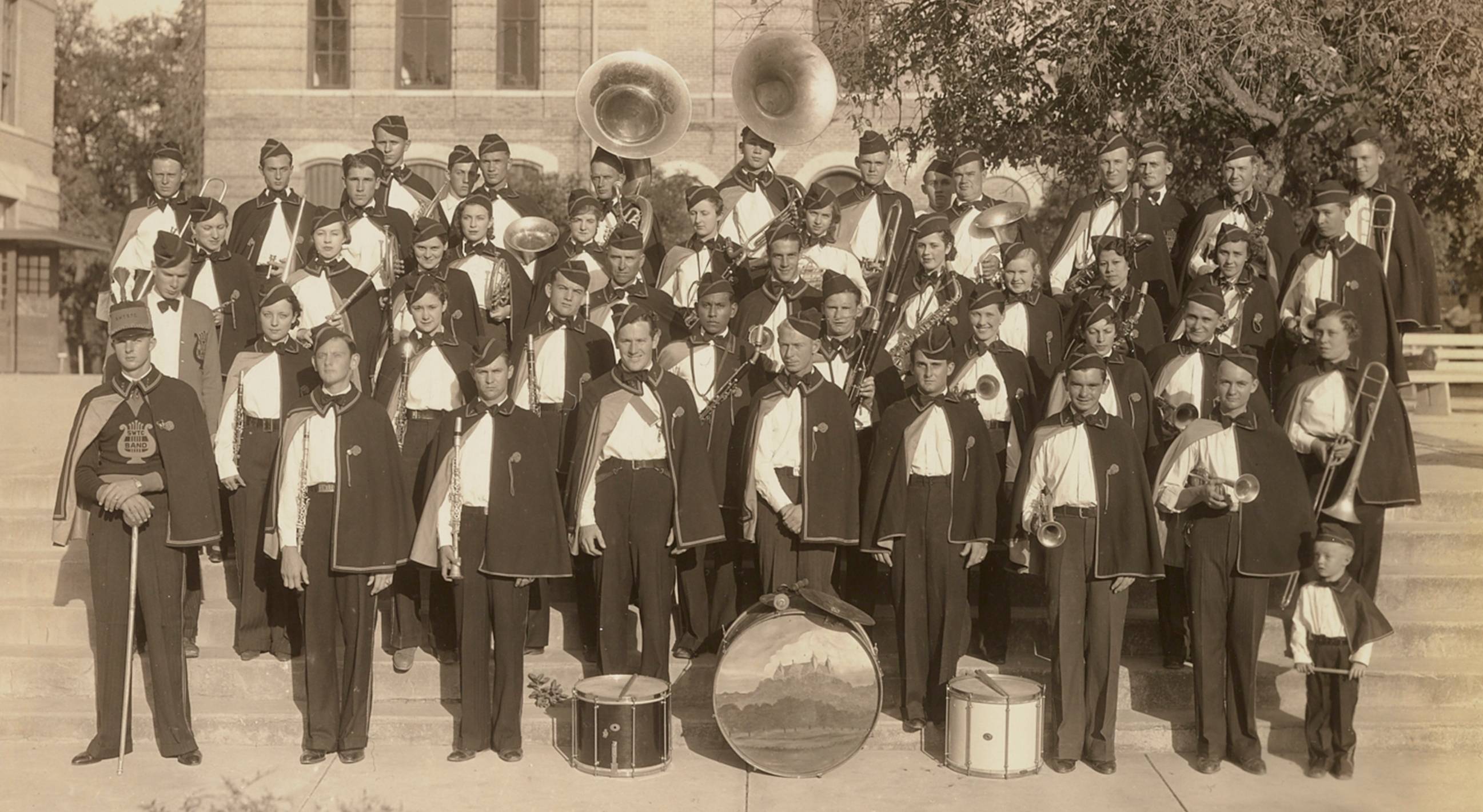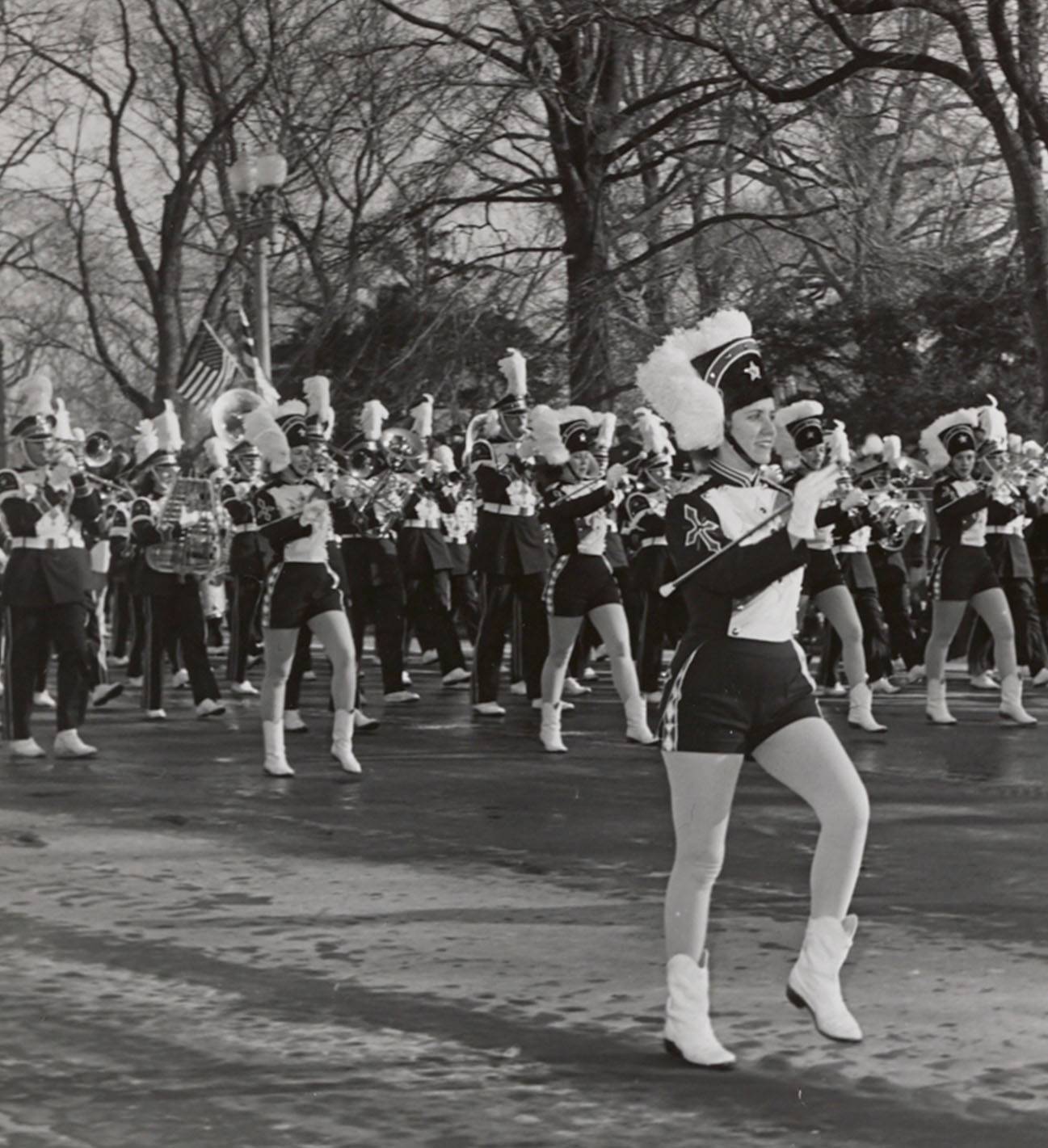
Texas Band program celebrates 100 years
By Kevin Mooney
It was Thanksgiving Day, November 1919, when a 16-member, student-led marching band first took to the field during halftime of the football game between Southwest Texas State Normal College and San Marcos Baptist Academy.
This fall, the Bobcat Alumni Marching Band kicks off a yearlong centennial celebration of the Texas State University band program. Celebration events will continue through the year, culminating in May with a gala celebration at the Performing Arts Center.
The band program has grown to include three concert bands — the Wind Symphony, Symphonic Winds, and Concert Band — as well as the Bobcat Marching Band and the Basketball Band. Indeed, a survey of its history over the past 100 years reveals that the significance of the band program to students, the university, and the community is far greater than spirited halftime performances.
Dr. Robert Augustus Tampke became the first faculty director in 1923, leading the band until 1950. In an interview from 1978, Tampke recalled the first time he accompanied the college band down to the old Evans Field for a game and they were stopped at the gate. “There were 10 or 12 of us in the band and [they] wanted us to pay admission.” Under Tampke’s direction, the band almost doubled in size, including 10 “town members” in two years. They were no longer asked to pay admission to perform at halftime.
The band members received their first uniforms in 1928. Impressively decked out in their maroon and gold with caps and capes, the band felt justified in making an extensive tour of Texas, with performances in Fredericksburg, Llano, San Saba, and other cities. Statewide tours became an annual expression of college pride as well as an effective recruitment endeavor.

By 1939, Tampke could boast of having the largest band in the history of the college with 52 members. The 1940s saw band membership drop with the onset of World War II, but also saw an increase of women members. As annual statewide tours continued after the war, membership increased as did their performances, supplying music for both football and basketball games. They had new uniforms the end of the decade and were soon under new leadership.
The early 1950s saw several directors until Dr. Anton “Tony” Bek was named director in 1954 and continued in the position throughout the decade. Bek expanded the band program significantly by forming a concert band in 1952. By 1955, the bands were recognized as two of the most active musical organizations on the Hill.

By the end of the decade, the band organization had slightly more than 40 members — and three years later membership had doubled. Such growth was largely due to the leadership of band director Maurice Callahan as well as four nationwide television appearances: the 1961 presidential inauguration parade in Washington, D.C., two shows in connection with the Sugar Bowl in New Orleans, and an NFL halftime show at a Houston Oilers game.
In 1961, Paul Yoder was commissioned to compose "Go Bobcats," the college fight song. After participating in President Lyndon B. Johnson's inauguration parade in 1965, the band received unprecedented national attention.

In 1975, Dr. James C. Sudduth took over direction of the marching band (and concert band), which garnered national attention with televised performances at the Astrodome.
The band organization continued to grow during the last two decades of the 20th century and into the 21st. John Stansberry, director from 1981 to 2006, significantly expanded membership and performance opportunities, reaching thousands of people each year. During this period, the bands performed at regional and national music conventions, as well as in the 1982 Hollywood film “The Best Little Whorehouse in Texas.”

In 2007, Dr. Caroline Beatty became associate director of bands and director of the Bobcat Marching Band. She was promoted to director of bands in 2011. The following year, Dr. Kyle Glaser became associate director of bands, with Matt Holzner beginning his term as assistant director in 2014.
As the band program moves toward its second 100 years, the Bobcat Marching Band is 340 strong, the three concert bands have more than 200 students, and the Basketball Band has 90 students each spring.
BAND PERFORMANCES OF NOTE
As the university celebrates this centennial milestone, it's worth noting a few of the more prestigious performances and accomplishments of just two ensembles of the Band program.
Bobcat Marching Band
- 2003 Monterrey, Mexico, the first U.S. marching band to performance at professional soccer game
- 2013 Selected video presentation at the College Band Directors National Association (CBDNA) National Conference
- 2014 Performance at Dallas Cowboys game and the Formula 1 United States Grand Prix at the Circuit of the Americas in Austin
- 2015 Performance at a Houston Texans game
- 2019 Selected video presentation at the CBDNA National Conference
Wind Symphony
- 2008 Kansas City, Missouri, jury-selected perforamnce at the CBDNA Regional Conference
- 2011 Seattle, Washington, jury-selected performance at the CBDNA National Conference
- 2014 Fayetteville, Arkansas, jury-selected performance at the CBDNA Regional Conference
- 2018 Houston, jury-selected performance at the CBDNA Regional Conference
- 2019 Temple, Arizona, jury-selected performance at the CBDNA National Conference